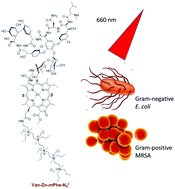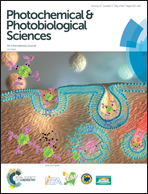Progressive cationic functionalization of chlorin derivatives for antimicrobial photodynamic inactivation and related vancomycin conjugates†
Abstract
It is known that multiple cationic charges are required to produce broad-spectrum antimicrobial photosensitizers (PS) for photodynamic inactivation (aPDI) or photodynamic therapy of bacteria and fungi. In the present study we describe the synthesis and aPDI testing of a set of derivatives prepared from the parent pheophytin molecule with different numbers of attached side arms (1–3) each consisting of five quaternized cationic groups (pentacationic), producing the corresponding [Zn2+]pheophorbide-a-N(C2N+C1C3)5 (Zn-Phe-N5+, 5 charges), [Zn2+]chlorin e6-[N(C2N+C1C3)5]2 (Zn-Chl-N10+, 10 charges) and [Zn2+]mesochlorin e6-[N(C2N+C1C3)5]3 (Zn-mChl-N15+, 15 charges). Moreover, a conjugate between Zn-Phe-N5+ and the antibiotic vancomycin called Van-[Zn2+]-m-pheophorbide-N(C2N+C1C3)5 (Van-Zn-mPhe-N5+) was also prepared. The aPDI activities of all compounds were based on Type-II photochemistry (1O2 generation). We tested these compounds against Gram-positive methicillin-resistant Staphylococcus aureus (MRSA), Gram-negative Escherichia coli, and the fungal yeast Candida albicans. All three compounds were highly active against MRSA, giving eradication (≥6 logs of killing) with <1.0 μM and 10 J cm−2 of 415 nm light. The order of activity was Zn-Phe-N5+ > Zn-Chl-N10+ > Zn-mChl-N15+. In the case of E coli the activity was much lower (eradication was only possible with 50 μM Zn-mChl-N15+ and 20 J cm−2). The order of activity was the reverse of that found with MRSA (Zn-mChl-N15+ > Zn-Chl-N10+ > Zn-Phe-N5+). Activity against C. albicans was similar to E. coli with Zn-mChl-N15+ giving eradication. The activity of Van-Zn-mPhe-N5+ was generally lower than that of Zn-Phe-N5+ (except for E. coli). Red (660 nm) light was also effective as might be expected from the absorption spectra. An initial finding that Van-Zn-mPhe-N5+ might have higher activity against vancomycin resistant Enterococcus fecium (VRE) strains (compared to vancomycin sensitive strains) was disproved when it was found that VRE strains were also more sensitive to aPDI with Zn-Phe-N5+. The minimum inhibitory concentrations of Van-Zn-mPhe-N5+ were higher than those of Van alone, showing that the antibiotic properties of the Van moiety were lessened in the conjugate. In conclusion, Zn-Phe-N5+ is a highly active PS against Gram-positive species and deserves further testing. Increasing the number of cationic charges increased aPDI efficacy on C. albicans and Gram-negative E. coli.



 Please wait while we load your content...
Please wait while we load your content...